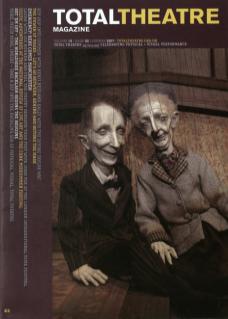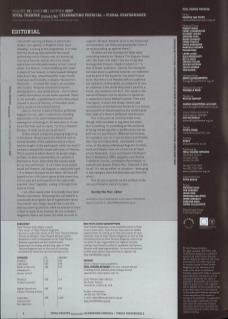I am at the opening of Blank, a new artists' studio-cum-gallery in Brighton (well, Hove actually). Looking at the programme, it is clear that the dividing lines between the visual/performing/sonic/literary arts are becoming ever more blurred: artists who have studio space here include performance artists (one of whom, Eva Weaver, is fortune-telling with toast in place of tea leaves), a mask/puppet designer (Aya Husni-Bey, whose beautiful triple-faced mask was seen recently in Voodoo Vaudeville's Mardi Gras – reviewed this issue), an animator who creates 'bespoke interactive projects', photographers, and sound artists – few of whom confine themselves to one modus operandi (there is, for example, a performance artist/bass player trained in physical theatre, a filmmaker/poet, and a sculpture/movement artist).
Also on the list is dance/theatre performer Augusto Corrieri, who I come across standing expectantly in his small whitewashed studio, evening sun streaming in. He welcomes us in, we sit on the floor and he starts. ‘So this is theatre,' he says, 'it must be as you're all here!'
In this simple and gently amusing beginning to his dance-theatre piece (in which he and an invited member of the audience dance a short routine taught to the participant whilst we watch) we have a beautifully simple definition of theatre. This is a piece in which there is no proper stage, no flats, no pre-scripted text, no curtains or blackout or music other than the sounds made by our two performers. It isn't what most people would call theatre, but Augusto is absolutely right – it is theatre because we are there. We have all agreed to be in the same space at the same time, and to stay put and experience this physically enacted 'story' together, seeing it through from start to finish.
I am often asked what it is exactly that Total Theatre represents. Answering this can lead to a convoluted description full of hyphenated terms (movement-led, image-based) but to me the obvious starting point for what we choose to cover is that it needs to be theatre. We are a theatre magazine; hence our name. It's what we exist to support. We take ‘theatre' to be a very broad and inclusive term, but there are boundaries (even if we enjoy pushing up against them).
So where are the boundaries? What does something need to be theatre'? As Augusto knows well, the most vital need – the one thing that distinguishes theatre, makes it what it is – is that it needs 'audience'. Live art (for example) can take place in splendid isolation; an audience may be part of the equation, but doesn't have to be. But there is no theatre without audience (an audience of thousands, an audience of one, an audience in the street that hasn't paid for a ticket, any audience will do!). This subject, the nature of theatre and its relation to audience is explored in Cassie Werber's article, ‘Time and Time Again’, in which the shows, events and installations at the National Review of Live Art are appraised from the perspective she understands best, that of a theatre performer and director.
This is the point at which to make clear, though, that one label or tag does not mean that something 'is' something to the exclusion of being something else: a performance can be both live art and theatre (NRLA artists Curious, for example), just as it can be dance and theatre (hip-hop artist Benji Reid, interviewed in this issue, or the above referenced Augusto Corrieri), mask and theatre (any one of our trio of mask artists featured), circus and theatre (Ockham's Razor reviewed at LIMF), puppetry and theatre (Indefinite Articles, reviewed in Manchester) or cabaret and theatre (Taylor Mac, featured in this issue). It's not an either-or situation – belonging in one category does not eliminate you from the other!
This all just scratches on the surface of the nature of theatre, but it's a start...

